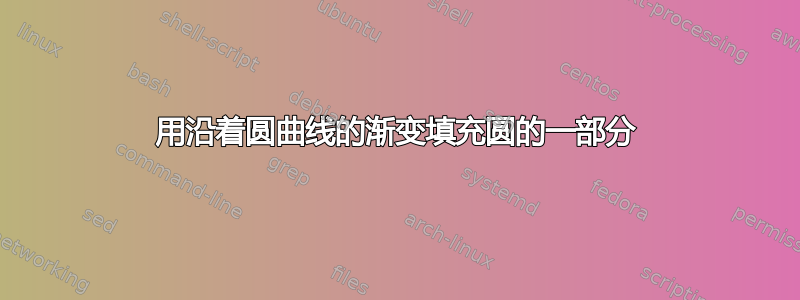
我想用渐变填充圆的下半部分(225° - 315°),该渐变朝向圆的曲线。225° 和 315° 处的整个边应该是颜色的起点。现在它朝向两侧的尖端。
\fill[lightgray] (0,0) -- (90:5) arc (90:225:5) -- cycle;
\fill[left color=lightgray, right color=white] (0,0) -- (225:5) arc (225:315:5) -- cycle;
我的想法是,渐变应该沿着像下面这样的路径(粗略地绘制在图像上),但我真的不知道如何实现这一点。我非常感谢任何对我有用的提示或信息链接。
[我看了这里,但它似乎不适合我的问题。
完整代码:
\documentclass[10pt]{article}
\usepackage{blindtext}
\usepackage{fancyhdr}
\usepackage{ragged2e}
\usepackage[utf8]{inputenc}
\usepackage[labelformat=empty]{caption}
\usepackage{tikz}
%\usepackage{wrapfig}
\usetikzlibrary{mindmap,shadows,trees,shapes,through, positioning, backgrounds, fadings}
\usepackage{geometry}
\geometry{
a4paper,
total={170mm,257mm},
left=15mm,
top=20mm,
right=15mm
}
\pagestyle{fancy}
\fancyhf{}
\rhead{\includegraphics[height=1.5cm]{XXX}}
\lhead{XXX}
%\rfoot{Page \thepage}
\begin{document}
\hfill
\centering
{\huge\textbf{mentales Lexikon\\}}
\bigskip
\textbf{Übung zur Elaboration/Speicherung von Wörtern}\\\smallskip von XXX
\bigskip
\begin{figure}[h!]
\begin{tikzpicture}[framed, text centered]
\coordinate (1) at (0,0);
\coordinate (2) at (0,5);
\fill[lightgray] (0,0) -- (90:5) arc (90:225:5) -- cycle;
\fill[left color=lightgray, right color=white] (0,0) -- (225:5) arc (225:315:5) -- cycle;
%fill=left!30!white
\draw[black] (0:5) -- (1);
\draw[black] (45:5) -- (1);
\draw[white] (90:5) -- (1);
\draw[white] (135:5) -- (1);
\draw[white] (180:5) -- (1);
\draw[white] (225:5) -- (1);
\draw[white] (270:5) -- (1);
\draw[black] (315:5) -- (1);
\node [draw, circle through=(2), very thick] at (1) {};
\node [align=center] (episodisch) at (22.5:3.3) {episodische\\Informationen};
\node [align=center,draw, fill=white] (epi_note) at (22.5:6.7) {Quadratisch. Praktisch. Gut.\footnotemark\\Informationen\\???};
\node [align=center] (prozedual) at (67.5:3.3) {prozeduale\\Informationen};
\node [align=center,draw, fill=white] (proz_note) at (67.5:6.7) {Informationen \\zur Handlung};
\node [align=center] (graphemisch) at (112.5:3.3) {graphemische\\Informationen};
\node [align=center,draw, fill=white] (graph_note) at (112.5:6.7) {Informationen \\zur Schreibweise};
\node [align=center] (morphologisch) at (157.5:3.3) {morphologische\\Informationen};
\node [align=center,draw, fill=white] (morph_note) at (157.5:6.7) {morphologische \\Informationen};
\node [align=center] (phonologisch) at (202.5:3.3) {phonologische\\Informationen};
\node [align=center,draw, fill=white] (phon_note) at (202.5:6.7) {kwadratisch\\ipa\\lautschrift};
\node [align=center] (syntaktisch) at (270:3.3) {syntaktische\\Informationen};
\node [align=center,draw, fill=white] (syn_note) at (270:6.7) {vor dem Nomen\\Informationen};
\node [align=center] (semantisch) at (337.5:3.3) {semantische\\Informationen};
\node [align=center,draw, fill=white] (sem_note) at (337.5:6.7) {viereckig\\mit gleich langen Seiten\\Mathematik: in der zweiten Potenz\footnotemark};
\node [align=center, draw] (lemma) at (0:7.5) {\textbf{Lemma}};
\node [align=center, draw, fill=lightgray] (lexem) at (180:7.5) {\textbf{Lexem}};
\node [rectangle, fill=white,draw] (quadratisch) at (0,0) {"quadratisch"};
\end{tikzpicture}
\caption[test]{Modell eines Lexikoneintrages zum Wort "quadratisch"\footnotemark}
\end{figure}
\bigskip
\justifying
\blindtext[1]
\footnotetext[1]{\raggedright Werbeslogan der Schokoladenmarke Ritter Sport der Alfred Ritter GmbH \& Co. KG}
\footnotetext[2]{\raggedright Artikel des Wörterbuchs der deutschen Gegenwartssprache, elektronische Version, (1974) abgerufen unter https://www.dwds.de/wb/quadratisch}
\footnotetext[3]{\raggedright Modell nach Luger (2006) zitiert aus Reber K \& Schönauer-Schneider, W.(2018). Bausteine sprachheilpädagogischen Unterrichts. München: Reinhardt Verlag}
\end{document}
答案1
\documentclass{article}
\usepackage{xfp}
\usepackage{tikz}
\begin{document}
\begin{tikzpicture}
\foreach \x in {0,...,100}
\fill[white!\x!lightgray]
(0,0) -- (\fpeval{\x=0 ? 225 : 225+\x*90/101-0.02}:5)
arc[start angle=\fpeval{\x=0 ? 225 : 225+\x*90/101-0.02},
end angle=225+\x*90/101+90/101,
radius=5] -- cycle;
\end{tikzpicture}
\end{document}
没有任何包装(当然除了 tikz)
\documentclass{article}
\usepackage{tikz}
\begin{document}
\begin{tikzpicture}
\foreach \x in {0,...,100}
\fill[white!\x!lightgray]
(0,0) -- (\ifnum \x=0 225 \else 225+\x*90/101-0.02 \fi:5)
arc[start angle={\ifnum \x=0 225 \else 225+\x*90/101-0.02 \fi},
end angle=225+\x*90/101+90/101,
radius=5] -- cycle;
\end{tikzpicture}
\end{document}
答案2
我能想到的最好的办法是:
\documentclass[10pt]{article}
\usepackage[utf8]{inputenc}
\usepackage{blindtext}
\usepackage{fancyhdr}
\usepackage{ragged2e}
\usepackage[labelformat=empty]{caption}
\usepackage{tikz}
%\usepackage{wrapfig}
\usetikzlibrary{mindmap, shadows, trees, shapes, through, positioning, backgrounds, fadings}
\usepackage{geometry}
\geometry{
a4paper,
total={170mm,257mm},
left=15mm,
top=20mm,
right=15mm
}
\pagestyle{fancy}
\fancyhf{}
\rhead{\includegraphics[height=1.5cm]{example-image-a}}
\lhead{XXX}
% \rfoot{Page \thepage}
\begin{document}
\hfill
\centering
{\huge\textbf{mentales Lexikon\\}}
\bigskip
\textbf{Übung zur Elaboration/Speicherung von Wörtern}\\\smallskip von XXX
\bigskip
\begin{figure}[h!]
\begin{tikzpicture}[framed, text centered]
\coordinate (1) at (0,0);
\coordinate (2) at (0,5);
\fill[lightgray] (0,0) -- (90:5) arc (90:225:5) -- cycle;
%\fill[left color=lightgray, right color=white] (0,0) -- (225:5) arc (225:315:5) -- cycle;
%%% polar gradient fill %%%
\begin{scope}
\clip (315:0) -- (315:5) arc (315:225:5) -- cycle;
\foreach \i in {1,...,100} {
\draw[white!\i!lightgray, line width=4pt]
({225+\i*(315-225)/100}:0) -- ({225+\i*(315-225)/100}:5);
}
\end{scope}
%%% === %%%
%fill=left!30!white
\draw[black] (0:5) -- (1);
\draw[black] (45:5) -- (1);
\draw[white] (90:5) -- (1);
\draw[white] (135:5) -- (1);
\draw[white] (180:5) -- (1);
\draw[white] (225:5) -- (1);
\draw[white] (270:5) -- (1);
\draw[black] (315:5) -- (1);
\node [draw, circle through=(2), very thick] at (1) {};
\node [align=center] (episodisch) at (22.5:3.3) {episodische\\Informationen};
\node [align=center,draw, fill=white] (epi_note) at (22.5:6.7) {Quadratisch. Praktisch. Gut.\footnotemark\\Informationen\\???};
\node [align=center] (prozedual) at (67.5:3.3) {prozeduale\\Informationen};
\node [align=center,draw, fill=white] (proz_note) at (67.5:6.7) {Informationen \\zur Handlung};
\node [align=center] (graphemisch) at (112.5:3.3) {graphemische\\Informationen};
\node [align=center,draw, fill=white] (graph_note) at (112.5:6.7) {Informationen \\zur Schreibweise};
\node [align=center] (morphologisch) at (157.5:3.3) {morphologische\\Informationen};
\node [align=center,draw, fill=white] (morph_note) at (157.5:6.7) {morphologische \\Informationen};
\node [align=center] (phonologisch) at (202.5:3.3) {phonologische\\Informationen};
\node [align=center,draw, fill=white] (phon_note) at (202.5:6.7) {kwadratisch\\ipa\\lautschrift};
\node [align=center] (syntaktisch) at (270:3.3) {syntaktische\\Informationen};
\node [align=center,draw, fill=white] (syn_note) at (270:6.7) {vor dem Nomen\\Informationen};
\node [align=center] (semantisch) at (337.5:3.3) {semantische\\Informationen};
\node [align=center,draw, fill=white] (sem_note) at (337.5:6.7) {viereckig\\mit gleich langen Seiten\\Mathematik: in der zweiten Potenz\footnotemark};
\node [align=center, draw] (lemma) at (0:7.5) {\textbf{Lemma}};
\node [align=center, draw, fill=lightgray] (lexem) at (180:7.5) {\textbf{Lexem}};
\node [rectangle, fill=white,draw] (quadratisch) at (0,0) {"quadratisch"};
\end{tikzpicture}
\caption[test]{Modell eines Lexikoneintrages zum Wort "quadratisch"\footnotemark}
\end{figure}
\bigskip
\justifying
\blindtext[1]
\footnotetext[1]{\raggedright Werbeslogan der Schokoladenmarke Ritter Sport der Alfred Ritter GmbH \& Co. KG}
\footnotetext[2]{\raggedright Artikel des Wörterbuchs der deutschen Gegenwartssprache, elektronische Version, (1974) abgerufen unter https://www.dwds.de/wb/quadratisch}
\footnotetext[3]{\raggedright Modell nach Luger (2006) zitiert aus Reber K \& Schönauer-Schneider, W.(2018). Bausteine sprachheilpädagogischen Unterrichts. München: Reinhardt Verlag}
\end{document}
代码本质上绘制了很多条线,它们的颜色逐渐从白色变为灰色,并且角度逐渐增大。
缺点:最后一行遮住了其他行,非常明显。






